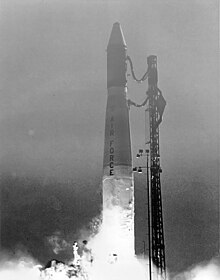Vandenberg Space Launch Complex 10
 A Thor DSV-2U carrying a DMSP weather satellite launches from SLC-10W in 1980. This was the last orbital launch from the complex. | |||||||||||||||||||||||||
 | |||||||||||||||||||||||||
| Launch site | Vandenberg Space Force Base | ||||||||||||||||||||||||
|---|---|---|---|---|---|---|---|---|---|---|---|---|---|---|---|---|---|---|---|---|---|---|---|---|---|
| Location | 34°45′55″N 120°37′20″W / 34.76528°N 120.62222°W | ||||||||||||||||||||||||
| Time zone | UTC−08:00 (PST) | ||||||||||||||||||||||||
• Summer (DST) | UTC−07:00 (PDT) | ||||||||||||||||||||||||
| Short name | SLC-10 | ||||||||||||||||||||||||
| Operator | United States Space Force | ||||||||||||||||||||||||
| Total launches | 38 | ||||||||||||||||||||||||
| Launch pad(s) | 2 | ||||||||||||||||||||||||
| Orbital inclination range | 51° – 145° | ||||||||||||||||||||||||
| |||||||||||||||||||||||||
Space Launch Complex 10 | |||||||||||||||||||||||||
| Location | Vandenberg Space Force Base, Lompoc, California | ||||||||||||||||||||||||
| Coordinates | 34°45′55″N 120°37′20″W / 34.76528°N 120.62222°W | ||||||||||||||||||||||||
| NRHP reference No. | 86003511[1] | ||||||||||||||||||||||||
| Significant dates | |||||||||||||||||||||||||
| Added to NRHP | June 23, 1986 | ||||||||||||||||||||||||
| Designated NHL | June 23, 1986[1] | ||||||||||||||||||||||||
Space Launch Complex 10 (SLC-10), or Missile Launch Complex 10,[1] is located on Vandenberg Space Force Base in Lompoc, California. It was built in 1958 to test ballistic missiles and developed into a space launching facility in 1963.[2] Prior to 1966, Space Launch Complex 10W (SLC-10W) was known as Vandenberg AFB Pad 75-2-6.[3] It remains a rare pristine look at the electronics and facilities created in that era that helped the United States grow its space capabilities.
The last launch from this complex was a Thor booster in 1980.[1] It was declared a National Historic Landmark in 1986.[1]
It is undergoing an eight-year restoration, and public visits are possible, if arranged in advance.[4]
History
The launch complex was built in 1958 by the Douglas Aircraft Corporation, and was first designated Complex 75-2. At that time it consisted of three launch pads, which were used to train military operators of PGM-17 Thor ballistic missiles, and to conduct missile launch tests. The first launches were conducted by the British Royal Air Force in June and August 1959.[1] The facilities at SLC-10 were dismantled and transported to Johnston Island in support of Operation Dominic, a nuclear weapons testing project conducted there in 1962.
The launch complex was rebuilt in 1963 to support the development of Burner rockets, with two launch pads, designated SLC-10E and SLC-10W. Tests were conducted at SLC-10W from 1965 to 1980, using the Thor satellite launch vehicles, the first stages of which followed the design of the Thor missile.
Surviving elements
Two launch pads and a prefabricated launch blockhouse are the principal surviving elements of the complex. The blockhouse interior still includes all of the electrical equipment used in later launches. SLC-10W also includes pipes and storage facilities for storing and managing the liquid fuel used in the rockets.[5]
Launch History
SLC-10W
SLC-10E
References
- ^ a b c d e f Staff. "NPS Focus: 86003511". National Register of Historic Places. National Park Service.
- ^ DOD NHL details for California
- ^ Ed Kyle (July 3, 2009). "Thor Burner - Sixth in a Series Reviewing Thor Family History".
- ^ NPS History of Aviation
- ^ "Space Launch Complex 10". National Park Service. Retrieved February 13, 2018.
Further reading
- Page II, Joseph T. (2014). Images of America: Vandenberg Air Force Base. Arcadia Publishing. OCLC 905345173.
- Page II, Joseph T. (2016). Space Launch Complex Ten: Vandenberg's Cold War Historic Landmark. History Press. OCLC 952155149.
- United States Air Force. (1998) Space Launch Complex 10: A National Historic Landmark. Brochure.
External links
- Aviation: From Sand Dunes to Sonic Booms, a National Park Service Discover Our Shared Heritage Travel Itinerary
- DOD NHL details for California
- Historic American Engineering Record (HAER) documentation, filed under North End of Aero Road, Lompoc, Santa Barbara County, CA:
- HAER No. CA-296, "Vandenburg Air Force Base, Space Launch Complex 10", 115 data pages
- HAER No. CA-296-A, "Vandenburg Air Force Base, Space Launch Complex 10, Blockhouse", 27 photos, 5 photo caption pages
- HAER No. CA-296-B, "Vandenburg Air Force Base, Space Launch Complex 10, Metal Building", 2 photos, 2 photo caption pages
- HAER No. CA-296-C, "Vandenburg Air Force Base, Space Launch Complex 10, Office and Administration Building", 7 photos, 3 photo caption pages
- HAER No. CA-296-D, "Vandenburg Air Force Base, Space Launch Complex 10, Technical Support Building", 9 photos, 3 photo caption pages
- HAER No. CA-296-E, "Vandenburg Air Force Base, Space Launch Complex 10, Hydrogen Peroxide Facility", 1 photo, 2 photo caption pages
- HAER No. CA-296-F, "Vandenburg Air Force Base, Space Launch Complex 10, East Launch Pad", 26 photos, 4 photo caption pages
- HAER No. CA-296-G, "Vandenburg Air Force Base, Space Launch Complex 10, Maintenance Support Building", 5 photos, 2 photo caption pages
- HAER No. CA-296-H, "Vandenburg Air Force Base, Space Launch Complex 10, West Launch Pad", 61 photos, 7 photo caption pages
- HAER No. CA-296-I, "Vandenburg Air Force Base, Space Launch Complex 10, Construction Storage Building", 3 photos, 2 photo caption pages
- HAER No. CA-296-J, "Vandenburg Air Force Base, Space Launch Complex 10, Power Substation", 1 photo, 2 photo caption pages
- HAER No. CA-296-K, "Vandenburg Air Force Base, Space Launch Complex 10, LE-8", 9 photos, 3 photo caption pages



